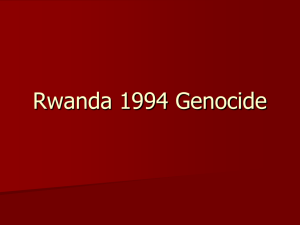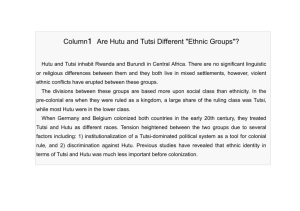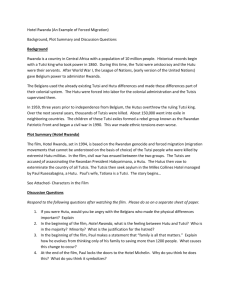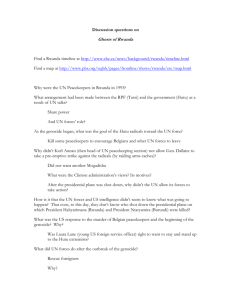Conflict & Civil War in Africa Worksheet
advertisement
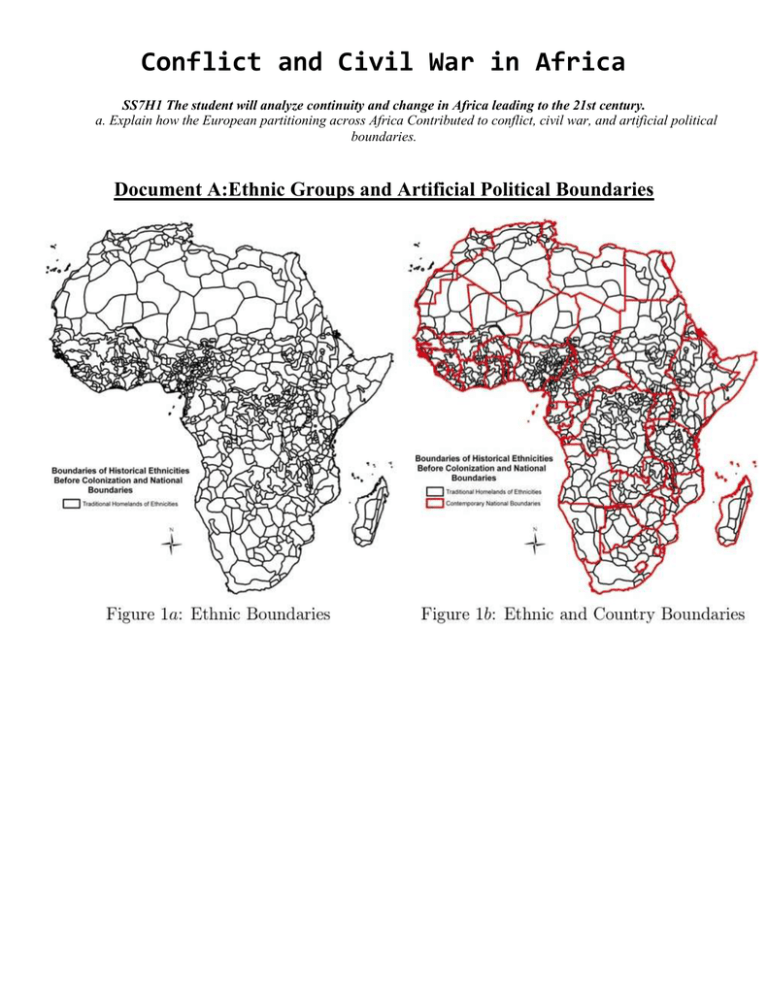
Conflict and Civil War in Africa SS7H1 The student will analyze continuity and change in Africa leading to the 21st century. a. Explain how the European partitioning across Africa Contributed to conflict, civil war, and artificial political boundaries. Document A:Ethnic Groups and Artificial Political Boundaries Document B: Armed Conflict in Africa Document C: The Cost of War Document D: Civil War in Rwanda Rwanda Genocide: A Short History of the Rwanda Genocide By Jennifer Rosenberg http://history1900s.about.com/od/rwandangenocide/a/Rwanda-Genocide.htm Beginning on April 6, 1994, Hutus began slaughtering the Tutsis in the African country of Rwanda. As the brutal killings continued, the world stood idly by and just watched the slaughter. Lasting 100 days, the Rwanda genocide left approximately 800,000 Tutsis and Hutu sympathizers dead. Who Are the Hutu and Tutsi? The Hutu and Tutsi are two peoples who share a common past. When Rwanda was first settled, the people who lived there raised cattle. Soon, the people who owned the most cattle were called "Tutsi" and everyone else was called "Hutu." At this time, a person could easily change categories through marriage or cattle acquisition. It wasn't until Europeans came to colonize the area that the terms "Tutsi" and "Hutu" took on a racial role. The Germans were the first to colonize Rwanda in 1894. They looked at the Rwandan people and thought the Tutsi had more European characteristics, such as lighter skin and a taller build. Thus they put Tutsis in roles of responsibility. When the Germans lost their colonies following World War I, the Belgians took control over Rwanda. In 1933, the Belgians solidified the categories of "Tutsi" and "Hutu" by mandating that every person was to have an identity card that labeled them either Tutsi, Hutu, or Twa. (Twa are a very small group of hunter-gatherers who also live in Rwanda.) Although the Tutsi constituted only about ten percent of Rwanda's population and the Hutu nearly 90 percent, the Belgians gave the Tutsi all the leadership positions. This upset the Hutu. When Rwanda struggled for independence from Belgium, the Belgians switched the status of the two groups. Facing a revolution instigated by the Hutu, the Belgians let the Hutus, who constituted the majority of Rwanda's population, be in charge of the new government. This upset the Tutsi. The animosity between the two groups continued for decades. The Event That Sparked the Genocide At 8:30 p.m. on April 6, 1994, President Juvénal Habyarimana of Rwanda was returning from a summit in Tanzania when a surface-to-air missile shot his plane out of the sky over Rwanda's capital city of Kigali. All on board were killed in the crash. Since 1973, President Habyarimana, a Hutu, had run a totalitarian regime in Rwanda, which had excluded all Tutsis from participating. That changed on August 3, 1993 when Habyarimana signed the Arusha Accords, which weakened the Hutu hold on Rwanda and allowed Tutsis to participate in the government. This greatly upset Hutu extremists. Although it has never been determined who was truly responsible for the assassination, Hutu extremists profited the most from Habyarimana's death. Within 24 hours after the crash, Hutu extremists had taken over the government, blamed the Tutsis for the assassination, and begun the slaughter. Document D: Civil War in Sudan Civil War in Sudan http://www.jewishworldwatch.org/wp-content/uploads/2010/06/brief_history_Grade4-9.pdf Northern Sudan was populated by people who practiced Islam, while Southern Sudan became rich in African culture and Christianity. In 1947, however, the British decided that Northern and Southern Sudan should unite to become one country. The British decision to make Sudan one country was a terrible mistake because the Northern and Southern people were so different, especially religiously, which led to the first civil war in Sudan in 1955. The first civil war in Sudan was a struggle to free Southern Sudan from the Islamic North part and lasted from 1955-1972. Between 750,000 and 1,500,000 Southern Sudanese died in this war. Finally, a peace agreement called the Addis Ababa Agreement was signed. Peace lasted for about ten years, but when the Southern Sudanese realized they would never gain true independence, they began to rebel. Sudan's second civil war started on May 16th, 1983. This civil war was largely about the desire on the part of the northern Sudanese to impose Islamic (Sharia) law on the entire country. Even though most of the people in the northern part of Sudan are Arab Muslims, Arab Muslims make up only around 33% of the total population of Sudan. In the civil war more than 2 million Sudanese Christians who lived in the south of Sudan were killed. The war was largely a religious war between Muslims and Christians. This war continued until an interim peace agreement was negotiated in 2005. The interim peace agreement will expire in 2010, at which time the Southern Sudanese are supposed to be able to vote about whether they want to be part of a unified Sudan, or whether they would rather form their own independent country. Many are doubtful about whether the northern Sudanese (Khartoum) government will ever really allow the southern Sudanese to exercise their option to become independent since there has been a lot of oil discovered in Southern Sudan. The present day situation in Sudan directly relates to the differences between the North and South. Ethnically, 69% of the population is African Sudanese, while the other 31 % is Arab Sudanese. Sudan has a big problem in that the government of Sudan only allows Islamic law to rule even though Muslims are a minority in the country. Ever since 1956 the majority of Sudanese have been excluded from their own government, and peace cannot occur unless Sudan's government changes and tolerates all religions and cultures to exist. Name: _________________________________ Conflict and Civil War in Africa SS7H1 The student will analyze continuity and change in Africa leading to the 21st century. a. Explain how the European partitioning across Africa Contributed to conflict, civil war, and artificial political boundaries. Document A 1. Estimate how many different ethnic groups there are across the continent of Africa. 2. What type of problems could arise because of this diversity? 3. Do the traditional homeland borders match with the contemporary national borders? 4. Who do you think drew the national boundaries of many of the African countries? 5. Which boundary line do you think has the most meaning to the people of Africa: their traditional boundaries or the contemporary national boundaries? Why? 6. What type of problems could arise from different ethnic groups being grouped together in one country? Document B 1. What are armed conflicts? 2. How many countries on the map have had episodes of one-sided violence? 3. How many countries on the map have had state-based armed conflicts? 4. How many countries on the map have had non-state armed conflicts? 5. Why do you think so many countries on the continent of Africa have had conflicts and civil wars? 6. Could the frequent violence throughout many African countries be linked to European partitioning? Explain. Document C Questions 1. How many African countries have had conflict between 1990 and 2005? 2. Since 1990, how much has war cost the economies of these African countries? 3. Which two countries have experience the greatest GDP loss because of wars? 4. How do conflicts and wars affect a country’s economy? 5. Why do wars and conflict affect a country’s economy? Document D 1. Read the article on the civil war in Sudan. Who was the civil war between? 2. Read the article on the civil war in Rwanda. Who was the civil war between? 3. Could the civil wars in Rwanda and Sudan be linked to European partitioning and colonization? Explain.
